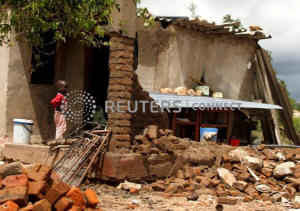|
Death toll in Mozambique cyclone, floods
could surpass 1,000: president
 Send a link to a friend
Send a link to a friend
 [March 19, 2019]
By Manuel Mucari [March 19, 2019]
By Manuel Mucari
MAPUTO (Reuters) - The number of people
killed in a powerful storm and preceding floods in Mozambique could
exceed 1,000, the president said on Monday, putting the potential death
toll greatly more than current figures.
Eighty-four deaths have been confirmed so far in Mozambique as a result
of Cyclone Idai, which has also left a trail of death and destruction
across Zimbabwe and Malawi, with vast areas of land flooded, roads
destroyed and communication wiped out.
Speaking on Radio Mocambique, President Filipe Nyusi said he had flown
over the affected region, where two rivers had overflowed. Villages had
disappeared, he said, and bodies were floating in the water.
"Everything indicates that we can register more than 1,000 deaths," he
said.
The cyclone has also killed 98 people and more than 200 are missing in
Zimbabwe, the government said on Monday, while the death toll in Malawi
from heavy rains and flooding stood at 56 as of last week. No new
numbers had been released following the cyclone's arrival in the
country.

Caroline Haga, a senior International Federation of the Red Cross
official who is in Beira, said the situation could be far worse in the
surrounding areas, which remained completely cut off by road and where
houses were not as sturdy.
Nyusi flew over areas that were otherwise accessible, and some of which
had been hit by flooding before Cyclone Idai.
RESCUE EFFORT
In Beira, Mozambique's fourth-largest city and home to 500,000 people, a
large dam had burst, further complicating rescue efforts.
Large swathes of land were completely submerged, and in some streets
people waded through knee-high water around piles of mangled metal and
other debris.
In the early hours of Monday morning, rescuers launched dinghies onto
chest-high waters, navigating through reeds and trees - where some
people perched on branches to escape the water - to rescue those trapped
by the flooding.
Meanwhile, rescuers were struggling to reach people in Zimbabwe's
Chimanimani district, cut off from the rest of the country by torrential
rains and winds of up to 170 kph that swept away roads, homes and
bridges and knocked out power and communication lines.
[to top of second column]
|

A boy looks on at a family home destroyed by floods following
Cyclone Idai in Chimanimani district, Zimbabwe, March 18, 2019.
REUTERS/Philimon Bulawayo

Zimbabwe's treasury has released $18 million to rebuild roads and
bridges, provide water and sanitation and electricity. Families
began burying the dead but the death toll is expected to rise.
Many people had been sleeping in the mountains since Friday, after
their homes were flattened by rock falls and mudslides or washed
away by torrential rains.
The Harare government has declared a state of disaster in areas
affected by the storm. Zimbabwe, a country of 15 million people, was
already suffering a severe drought that has wilted crops.
SOUTHEASTERN AFRICA GATEWAY
Beira, which sits at the mouth of the Pungwe River, is also home to
Mozambique's second-largest port, serving as gateway for imports to
landlocked countries in southeast Africa.
The director of a company that jointly manages the port, Cornelder,
based in the Netherlands, said the port had been closed since last
Wednesday but would hopefully resume operations on Tuesday.
Two cranes would be working and the company had two large generators
and enough fuel for now, though damage to access routes and roads
further inland was more likely to cause a problem, said the
director, who asked not to be named.
The fuel pipeline running from Beira to Zimbabwe was believed to be
intact, the person said, though communication was still very patchy
and therefore the situation at the port remained uncertain.
In February 2000, Cyclone Eline hit Mozambique when it was already
devastated by its worst floods in three decades. It killed 350
people and made 650,000 homeless across southern Africa, also
hitting Zimbabwe.
(Additional reporting by MacDonald Dzirutwe in Zimbabwe and Emma
Rumney in Johannesburg; Editing by Angus MacSwan)
[© 2019 Thomson Reuters. All rights
reserved.]
Copyright 2019 Reuters. All rights reserved. This material may not be published,
broadcast, rewritten or redistributed.
Thompson Reuters is solely responsible for this content. |